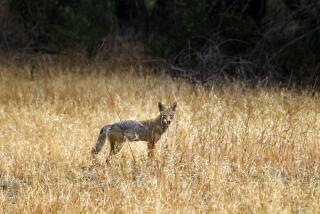Opportunity Knocks, Bumps as Critters Lodge in Homes
- Share via
NASHVILLE, Tenn. — Don Ellis has heard all the horror stories.
Homeowners awakening to the scamper of tiny paws in the bedroom wall. Peering with a flashlight into darkened crevices. Slinking through a musty crawl space to bait traps with peanut butter and acorns.
The frazzled homeowners remind Ellis of Bill Murray’s groundskeeper character in the movie “Caddyshack.” The film ends with Murray blowing up a golf course to get rid of a troublesome gopher.
“I’ll get frantic calls at 2 and 3 in the morning,” said Ellis, who receives 10 to 15 pleas a day to remove animals.
The problems range from squirrels in the attic to snakes in the basement, from potbellied pigs digging up the yard to raccoons sleeping in the bathtub.
“My job is like going on a safari every day,” Ellis said.
The 51-year-old former police officer got the idea for a wildlife-control business in 1990 after capturing a skunk in his own backyard.
“I called the state and just about everybody else trying to get rid of it. But surprise, surprise, nobody wanted it,” said Ellis, who ended up releasing the animal himself in a wildlife area.
Others noticed the void too.
Nuisance animal control services were virtually nonexistent a decade ago. Today, as suburban sprawl continues to shrink the wildlife habitat, it is an emerging industry with an estimated 10,000 operators nationwide, said Robert Schmidt, an associate professor of wildlife at Utah State University and a leading authority on the business.
Wild animals cause an estimated $3.8 billion in damage annually in the top 100 metropolitan areas of the country, according to a study published in 1997 by Utah State.
Squirrels are fond of chewing electrical wires. Woodpeckers can damage siding. Beavers chew up ornamental trees.
And raccoons are the worst.
“They’ll climb up through the duct work, set off your alarm and absolutely tear up your house,” Ellis said.
Still, environmental groups say animals are not the enemy and urge homeowners to be wary of wildlife-control operators.
Wildcare, a wildlife-rehabilitation center in Woodbridge, Canada, says some operators use inhumane methods of removal. It encourages trapping the animals and setting them free later.
In fact, trap sales are better than ever, say officials with Woodstream Corp. of Lititz, Pa., which manufactures Havahart animal traps. The cages are sold for between $10 and $75 each.
“A lot of people who move into rural areas do so because they enjoy nature. When they have a nuisance animal, they want to remove them as humanely as possible,” company spokesman Carolyn Warfel said.
Billy Dukes, a biologist with the South Carolina Department of Natural Resources, said homeowners can avoid most problems by cleaning up spilled pet food, properly disposing of food scraps, locking trash can lids and keeping homes sealed.
Many states require animal-control operators to get permits, but standards vary widely. Illinois requires a rigorous written test, for instance, while Tennessee asks applicants merely to show they have experience working with wildlife.
“I think the professionalism has increased each year,” said Ed Warr, a wildlife biologist with the Tennessee Wildlife Resources Agency, which has issued permits since 1989.
Schmidt said state wildlife agencies have encouraged the industry to blossom because “they just don’t have time to deal with every person who calls with a squirrel problem.”
Training used to be limited to state trapping conventions, but workshops are now available annually through a trade magazine and the National Animal Damage Control Assn., which has 500 members.
Concerns from humane societies have prompted some states and cities to ban certain traps and pesticides and to institute guidelines for animal control operators to follow when disposing of an animal--dead or alive.
“It’s important for people to remember that wildlife damage management is not about aimlessly destroying animals,” Schmidt said. “It’s about managing animals that have crossed the line.”
Schmidt said it is appropriate for individual states to oversee the industry because wildlife problems vary regionally.
In Utah, a major livestock-production state, coyotes and foxes are threats. Texas has its armadillos, Gulf states have their alligators. The Northwest struggles with black bears, mountain beavers and moles. White-tailed deer and beavers cause problems in the Northeast.
Nationwide, consistent nuisances include raccoons, skunks, bats, pigeons, starlings and sparrows.
More to Read
Sign up for Essential California
The most important California stories and recommendations in your inbox every morning.
You may occasionally receive promotional content from the Los Angeles Times.













